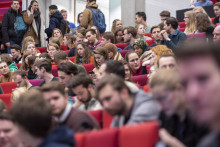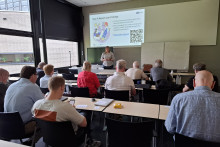The idea to form a Faculty Club occurred to Dave Blank (Professor of Inorganic Materials Science in the faculty of Science and Technology) after doing a sabbatical at Stanford University in California. The Stanford Faculty Club is a private membership organization which plays a vital role in promoting “opportunities …to meet and to socialize in a relaxed environment.” Blank was not alone. Among others, Blank's colleagues Albert van den Berg (BIOS group in EEMCS) and Leo Goedegebuure (CHEPS) had the same idea, based on similar positive experiences at universities abroad. Blank explains that creating a “place where people from different disciplines could meet in an informal way” appealed to all of them. Rector Magnificus van Vught supported the idea of a faculty club but insisted that it be initiated by the faculty and staff themselves. With UT Nieuws editor-in-chief Bert Groenman, the men formed a steering committee to found the UT Faculty Club.
Faculty Club membership is open to every faculty and staff member of the UT community, technically including AIOs. Individual membership costs 50 euros per year; institutional membership ranges from 2,500 to 10,000 euros per year. The Faculty Club began its existence with 50,000 euros from the UT to equip its private lounge and another 50,000 euros for its fledgling budget.
The Faculty Club building is open to the general public. There one can sit and enjoy a quiet read or a cup of coffee. Most visitors come for lunch or dinner at the sleek new restaurant, open for dining weekdays from 12-8 pm. The facilities are also available for private meetings and receptions. Raymond Linderhof, the Faculty Club restaurant and catering manager, tells that the restaurant can host up to 250 people per function.
Within the Faculty Club building is a special lounge reserved for Faculty Club club members referred to as the Blomzaal, so named for the architects Piet Blom, who designed De Boerderij, and his son Abel Blom, who renovated the building to become the Faculty Club almost forty years later. In this elegant yet gezellige room, Faculty Club members may converse and carouse with their fellow members on weekdays from 12-2 pm and 4:30-9 pm.
More than merely a social organization, the Faculty Club is planning a lecture series in the near future on the impact of research on society, in which the technical and social aspects of the university merge. These colloquia will be in both Dutch and English. The FC also sponsors small expositions from the UT faculties and institutes, on view within the Faculty Club building.
In addition, a happy hour is scheduled for Thursday, May 27 at which a Dutch soccer expert will discuss the chances of the Dutch national soccer team at the European Cup in Portugal.
Blank reports that the Faculty Club has enjoyed a positive response so far from the UT community, “People like the idea.” To date there are 350 members, largely under the aegis of institute membership. Blank has high hopes for the future of the Faculty Club, expressing a desire that it become a normal way of welcoming guests or of meeting UT colleagues for an after-hours drink. “I hope that such a faculty club will be for faculty members and by the faculty members. It has to come from the people.” Above all, Blank insists that the Faculty Club must not be elitist. He wants individuals to feel at home in the Blomzaal.
For more information on the organization, see the Faculty Club website: www.utwente.nl/facultyclub or write to [email protected]
For more information regarding the Faculty Club restaurant, see:
http://www.utwente.nl/fb/catering/faculty_club/index.html








